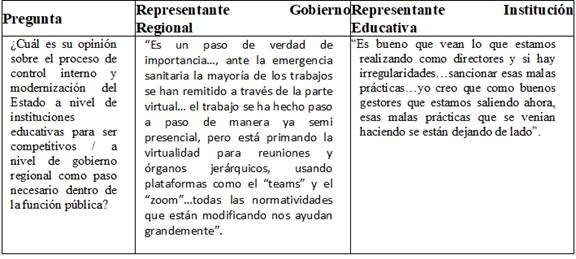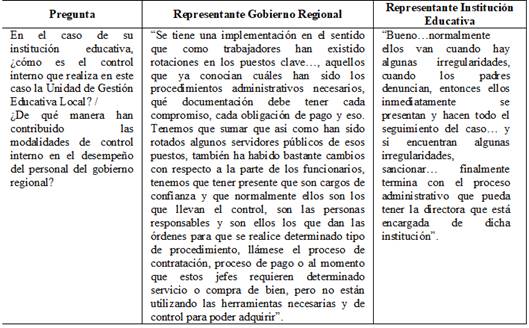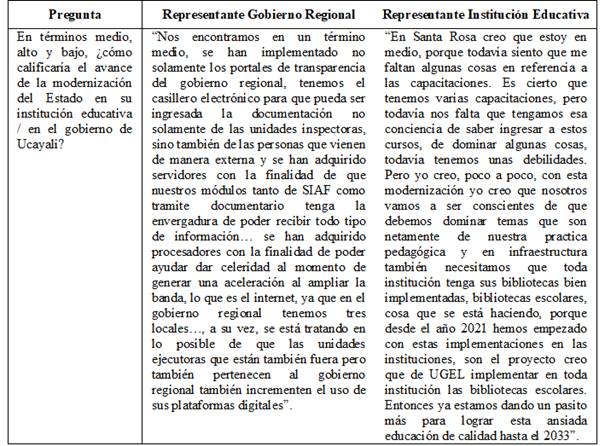My SciELO
Services on Demand
Journal
Article
Indicators
-
 Cited by SciELO
Cited by SciELO
Related links
-
 Similars in
SciELO
Similars in
SciELO
Share
EduSol
On-line version ISSN 1729-8091
EduSol vol.22 no.80 Guantánamo July.-Sept. 2022 Epub July 20, 2022
Original article
Internal control and modernization of the state in a Peruvian regional government and educational institution
1Universidad Cesar Vallejo, Perú
2Universidad Nacional de Ucayali, Perú.
Internal control and state modernization are part of a reform process that seeks to overcome the limitations and setbacks of public management in its different institutions, which has become a matter of interest in Peru. In this sense, we present the results of a research developed under a qualitative perspective with the purpose of knowing the progress of this process at present, for which a documentary review and an interview to two key informants were carried out, who locate the status of the changes undertaken in a government and in an educational institution at the middle level.
Keywords: Internal control; State modernization; Regional government; Educational institution
Introduction
The process of internal control and modernization of the country is described at the governmental level as a reform sought by the Peruvian State with the purpose of offering its population a renewed governmental institution that performs its activities framed in a focus on citizen service, efficiency in the fulfillment of its objectives and the provision of quality goods and services. This implies a migration in its course, so as to emphasize the achievement of results and the adoption of adaptable and flexible instruments; in short, it is a matter of implementing management by processes (Cañari-Otero and Hancco-Bustinza, 2021).
Under this type of management, the organization or institution is conceived as an interrelated system, whose activities are aimed at generating a product or service that seeks the satisfaction of the population. Following this orientation implies recognizing the importance of the relationship between the different phases of an activity, even allowing to simplify it, which includes being clear about the expected result for the common citizen and directing its actions towards the recovery of confidence in public institutions and their officials. At the formative level, it covers the service known in Peru as attention modules in the Local Educational Management Unit (UGEL) (Maizondo and Hidalgo, 2021).
In this regard, it is worth mentioning that, within the framework of the country's state reform, an international seminar was held in May 2021 under the name "The reform of the State. For an efficient State at the service of the people", where the need for the State to recover its essence was raised: to be at the service of the population, of its people, in a way that shows its conditions to really satisfy their requirements, given that not all the answers are covered by an increase in the budget.
In this sense,
A survey by Pulso Peru, prior to the pandemic, shows low citizen satisfaction with public services. Citizen satisfaction with services (security, health, justice, education and transportation) is around 50%. Social programs do not satisfy the population either (Barrios, 2022, p. 9).
Considering this scenario, a qualitative research was conducted with the purpose of knowing the progress of this process at present, for which a documentary review and an interview with two key informants, one representative of a regional government and the other of an educational institution, were carried out in order to obtain their perception in this regard.
Development
Towards the reform of the State and the modernization of the public sector in Peru.
The search for improvement in a quality service for the population involves recognizing that optimizing productivity and the possibility of creating value in public entities go hand in hand, being their products the goods and services provided to citizens through their institutions or action programs.
Hence, an improvement in productivity is attainable when the same amount of results is achieved with fewer elements, but it is also understood as the achievement of a greater amount of results with the same resources; aspects that can be replicated at any level of government or public administrative unit.
In a complementary manner, efficiency is understood as the ability to have the necessary factors to achieve a given effect, while effectiveness is linked to the possibility of achieving the expected result. In the public sphere, it means complying with institutional programs and plans, achieving the planned objectives, which makes it possible to evaluate the extent to which the agency has achieved the results it set out to achieve within the established period (National School of Public Administration - National Civil Service Authority (SERVIR), 2021).
The current Peruvian process began in 2013, with the approval of Supreme Decree N°004-2013-PCM, which sets out the National Policy for the Modernization of Public Management for the year 2021 (Secretariat of Public Management of the Presidency of the Council of Ministers, 2013). Thus, the governing body of this document sets forth a reform of the public apparatus based on the achievement of results that meet citizens' expectations and needs. With this, it states the requirement to migrate towards a management by processes contained in the value chains of each institution, so that they can ensure that the goods and services they are in charge of produce results and positive effects for the citizens, for which it presented a methodology framed in the aforementioned decree.
According to Arobes (2022), it is important to explain to citizens how the modernization of public management is key to state reform, so that they are aware of the processes involved and the impacts they can cause.
In reference to this approach, the starting point is to know and understand citizens' perception of the State, together with an analysis of the capacity of public officials to implement changes in order to make reform proposals. The idea is to ensure that this modernization contributes to the generation of public value and the improvement of the services provided to the country's various communities, thereby also seeking to regain their trust and the relegitimization of the State.
In this regard, it must be recognized that basic services are not provided in a timely and effective manner, and do not meet any quality standards, in addition to the situation of neglect observed in the rural areas of the coast, the Andean zone and the Amazon area. This situation became more complex with the outbreak of the pandemic, which revealed the fragility of the education and health sectors, both in terms of infrastructure and human resources. Likewise, the problem of paperwork is visible, whose regulations and requirements do not contribute to its prompt completion, further complicating the need to efficiently satisfy the community.
This scenario leads to citizen dissatisfaction with the State and distrust in the work of its institutions, especially at the ministerial and local government levels, with the Ombudsman's Office being an exception, according to figures from the National Institute of Statistics and Informatics (INEI) (Arobes, 2022). On the other hand, the high turnover rate of personnel dedicated to public service limits the continuity of the state reform process.
To exemplify this situation, it is worth mentioning that this process began in 2017 and should have been completed in a year and a half by legal mandate, but this type of changes, the constant restarting of training for new personnel, providing new members with the required technical advice and increasing working hours, restrict the continuity of activities and the maintenance of an internal memory in the organizations, thus affecting the achievement of the objectives set (Arévalo and Delgado, 2020).
Therefore, the modernization of public administration is a process of constant transformation to improve the work of public entities and, in this way, generate public value for the people. Translating this, which seems very technical, we will say that the modernization of public administration is the increase in the quality of goods and services, the opportunity to have multiple channels so that citizens can carry out their transactions, so that they can count on essential services throughout the national territory (Arobes, 2022, p. 32).
On the other hand, the emergence of the pandemic has only confirmed a reality characterized by shortcomings and lack of coordination in the development of public processes at all levels, which has been called state ostracism by Ugarte (2022).
From his perspective, citizens do not feel part of them, neither for responsibility nor for benefits, they only express their distrust towards the people and institutions that make life in that area of the country, making them see the delivery of economic bonds to vulnerable families as a half-hearted management of a dysfunctional entity. The panorama is complicated by the attempts at internal control, which have not proven to be effective either, but which have influenced capable professionals not to perceive any incentive before the possibility of being part of public institutions.
In this way, Ugarte (2022) highlights the following aspects:
The discretionality of government power linked to citizen trust manifests itself as an unequal relationship.
The distrust felt by the population towards the management of governmental entities has given way to various regulations that attempt to control civil servants, who are perceived as an obscure element within the state sphere, revealing the discrediting of the field of labor positions related to politics. It is a dynamic that traps those who dare to enter this world, due to the numerous regulations and controls, which also hinders attempts to establish reforms aimed at improving existing processes.
Adding that this is a distrust derived from a status of corruption that is not recent and that in the face of the implemented attempts at regulation shows that the attempts at innovation and reform are not entirely real, falling into "...the trap of the capacity of public entities" (Ugarte, 2022, p. 40), emphasizing that "...regulations are not the result of public management. They are only means...insufficient to solve society's problems" (Ugarte, 2022, p. 42).
This author adds, in correspondence with the above, that the required adjustments must contemplate:
The heterogeneity of the public sector, that is, the recognition of the diversity of each instance, avoiding the tendency to a general modelization.
The establishment of links with private companies and social demands that favor the generation of collaborative and transparent long-term actions.
An urgent review of the internal state regulations that promote the recovery of the margins of reasonable discretion for public officials, as well as the targeting of civil service areas that need immediate intervention.
Establish implementation times for regulations that allow them to mature, which means that they must transcend administrative periods in order to take hold.
Results
After reviewing the documentation compiled and conducting the interviews with key officials, the results of the latter are presented in four tables that summarize the opinions expressed in response to four basic questions, showing an overview of the current situation in a regional government and an educational institution. At the request of the interviewees, their anonymity is maintained, distinguishing their contributions under the term representative of each area.
In this sense, Table 1 presents the answers received to the question referring to the opinion they have on the internal control and modernization process of the State, showing a positive perspective that coincides with Cañari-Otero and Hancco-Bustinza's (2021) proposals regarding the migration of course, the achievement of results and the adoption of adaptable and flexible instruments in accordance with process management, such as the use of virtual platforms and sanctions for bad practices in order to reduce them.
Table 1: Opinion on internal control process and modernization of the State.

Source: Own elaboration.
Table 2, in turn, contemplates the changes that the interviewees have observed in their respective institutions, highlighting that at the governmental level it is recognized that they have been few, mainly due to the complexity of the process and the need for a suitable connection that favors online communication of different government agencies distributed in different areas of the country, thus corroborating the need to have the opportunity to have different channels throughout the country (Arobes, 2022).
While at the educational level it favors that its representative is part of a new building, where they have started with a program called "my maintenance", with which efforts are directed towards an adequate use of available resources, also coinciding these aspects with the approaches of Arobes (2022) regarding the need to explain to citizens the aspects related to the modernization of a public management.
Table 3 shows the responses received to the question on internal control implemented in public entities, characterized in the regional government by the rotation of personnel in key positions in an attempt to control the problems that existed some time ago due to the "power of decision" that the permanence in those same positions could give them, as mentioned by Ugarte (2022). At the same time, in the educational organizations, the participation of parents is perceived, who are encouraged to make the required complaints when any irregularity is detected; in this way, the statement of Maizondo and Hidalgo (2021) is verified in reference to the attention modules that operate in the UGEL.
Table 3: Modalities of internal control in educational institution / regional government

Source: Own elaborationSource: Own elaboration
Next, Table 4 contains the qualification that the interviewees assign to the progress of the modernization of the State, agreeing in placing it at a medium level, considering the aspects that have been implemented and the limitations that are still present to give way to a management of processes in their totality and to the offering of a quality service to the citizenship. Elements that recall the aspects mentioned by Ugarte (2022) on the dynamics of the public sector, which needs to be overcome to gain the trust of citizens with transparent activities, while respecting the intrinsic characteristics of each State agency. In addition to following the methodology released at the time through the document issued by the Secretariat of Public Management of the Presidency of the Council of Ministers (2013).
Conclusions
As in any process of internal control and state modernization, Peru does not escape the uncertainty generated by changes in the structure and modalities of attention to the community from regional governments and educational institutions, as shown by the expressions of the representatives of the regional government and the educational institution contacted. These are adjustments that in one way or another confront the usual bureaucratic culture with the purpose of gaining participation and satisfaction of needs. It also aims at stimulating change and obtaining better results in the management of each unit. The priority should be to serve the citizens and follow processes of continuous improvement.
In any case, although the results of the interviews place its progress at a medium level, it is clear that the road ahead is incomplete, according to the documentation consulted. Considering that the final objective expected from this reform of government entities should be the elimination of continuity and bureaucratic routine, as well as administrative procedures that do not add value to the work of the public sector, emphasis should be placed on the understanding that each official must have to make an appropriate use of the resources available and the importance of a continuous evaluation of efficiency to be able to offer quality public management
Referencias bibliográficas
Arévalo, F. y Delgado, J. (2020). Evaluación según modernización del Estado en la gestión municipal.Ciencia Latina Revista Científica Multidisciplinar, 4(2), p.914-935. https://doi.org/10.37811/cl_rcm.v4i2.131 [ Links ]
Arobes, S. (2022). La modernización de la gestión pública como clave para la reforma del Estado. En Corrales, A. (Ed.), Pautas para la reforma del Estado en el Perú: por un Estado eficiente al servicio de la gente (pp. 30-36). Perú: Fondo Editorial Universidad Continental. [ Links ]
Barrios, F. (2022). Presentación. En Corrales, A. (Ed.), Pautas para la reforma del Estado en el Perú: por un Estado eficiente al servicio de la gente (pp. 9-10). Perú: Fondo Editorial Universidad Continental . [ Links ]
Cañari-Otero, C. y Hancco-Bustinza, P. (2021). Influencia de la gestión por resultados en la efectividad de las políticas de reforma y modernización del Estado. Polo del Conocimiento, 6(2), 744-763. doi: 10.23857/pc.v6i2.2310 [ Links ]
Escuela Nacional de Administración Pública - Autoridad Nacional del Servicio Civil (SERVIR). (2021). Gestión por procesos para la administración pública. Cuaderno de trabajo.Lima:Escuela Nacional de Administración Pública - Autoridad Nacional del Servicio Civil. [ Links ]
Maizondo, F. e Hidalgo, I. (2021). Modernización y calidad del servicio en la Ugel N° 01, San Juan de Miraflores, Lima, 2019.Revista Gobierno y Gestión Pública, 8(1), 61-75.https://doi.org/10.24265/iggp.2021.v8n1.06 [ Links ]
Secretaría de Gestión Pública (SGP) de la Presidencia del Consejo de Ministros (PCM). (2013). Documento orientador: Metodología para la implementación de la Gestión por Procesos en las entidades de la Administración Pública en el marco del D.S. N°004-2013-PCM - Política Nacional de Modernización de la Gestión Pública. [ Links ]
Ugarte, M. (2022). La simplificación y la confianza: los grandes retos para innovar y modernizar. En Corrales,A. (Ed.), Pautas para la reforma del Estado en el Perú: por un Estado eficiente al servicio de la gente (pp. 37-44).Perú: Fondo Editorial Universidad Continental [ Links ]
Received: February 10, 2022; Accepted: May 16, 2022











 text in
text in 





